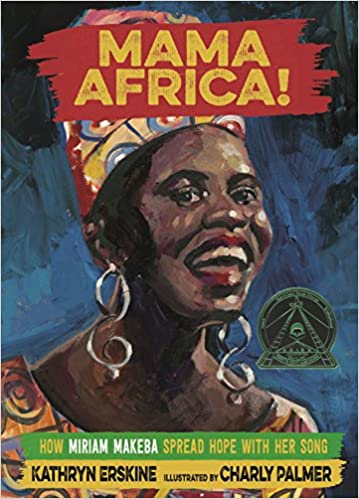Lesson 1: Learning “Pata Pata”
Aim: How can the lyrics and steady beat of a song inspire movement?
Summary: Students will learn to sing the response in “Pata Pata”; explore the musical elements of kwela; and move to the steady beat.
Materials: Music Explorers online audio, plastic straws
Standards: GA: ESGMK-2.PR.1, ESGMK-2.PR.3, ESGMK-2.RE.1, ESGMK-2.RE2, ESGMK-2.RE.3, ESGMK-2.CN.1, ESGMK-2.CN.2
SC: GM.P NL-AH.3, GM.R NL-AH.6, GM.R NL-AH.7, GM.C NL-AH.8, GM.C NL-AH.9
Vocabulary: kwela, pennywhistle
See Glossary →
Sing “Pata Pata”
“Pata Pata” is a song by Grammy Award-winning South African singer and civil rights activist Miriam Makeba. It was originally sung, recorded, and released by an all-female group called The Skylarks.
- Listen to “Pata Pata,” Track 18.
- What other kinds of music does this song remind you of?
- What instruments do you hear in this song?
Miriam Makeba
Zenzile Miriam Makeba (1932 – 2008) was a South African singer, songwriter, actress, and civil rights activist. She was born in the township of Prospect near Johannesburg and had a very difficult upbringing, with her father passing away when she was only six years old. Her name “Zenzile” is a traditional Xhosa word, often given to overcome life’s difficulties. Miriam started her career as the only woman in the otherwise all-male South African harmony group, Cuban Brothers. She later joined another all-male jazz group called the Manhattan Brothers and then finally the all-woman group, the Skylarks, in 1956. As an international performer who sold out the most prestigious concert halls all over the world, Miriam used her voice to also speak out against Apartheid (see below) and fight for equality for black South Africans.
- Learn the lyrics using “Pata Pata” pronunciation, Track 19.
“Pata Pata”
Saguquga sathi bega (nantsi Pata Pata)
Saguquga sathi bega (hiyo Pata Pata)
Saguquga sathi bega (nantsi Pata Pata)
Saguquga sathi bega (hiyo Pata Pata)
So we grooved and said, “check it out!”
This is the Pata Pata.
So we grooved and said, “check it out!”
This is the Pata Pata.
Hiyo mama hiyo ma (nantsi Pata Pata)
Hiyo mama hiyo ma (hiyo Pata Pata)
Hiyo mama hiyo ma (nantsi Pata Pata)
Hiyo mama hiyo ma (hiyo Pata Pata)
That’s it, lady!
This is the Pata Pata.
That’s it, lady!
This is the Pata Pata.
- Learn to sing the call and response to “Pata Pata,” Track 20.
- What other songs have we learned that use call and response?
- You can reflect back on the use of call and response in Ring Shout (Unit 1).
- Divide the class into two groups. Have one group sing the call and the other group sing the response.
Explore Instruments in Kwela
- Kwela music features a metal pennywhistle, a cheap and portable flute instrument used to imitate the saxophone in Western jazz music. Two of the most famous pennywhistle or “kwela flute” players were Spokes Mashiyane and Lemmy Mabaso. Below is a video of Lemmy Mabaso with the Makgona Tsohle Band.
- Kwela music was first played by street bands and, in its early days, would have typically included an acoustic gutiar and a washtub bass to accompany the pennywhistle. As the genre rose in popularity and began to be professionally recorded, the saxophone, drums and string bass became more common.
Explore South African Languages
- The lyrics of “Pata Pata” are in the Xhosa language, one of eleven official languages of South Africa (Ndebele, Pedi, Sotho, Swati, Tsonga, Tswana, Venda, Xhosa, Zulu, Afrikaans, and English). However, there are thirty-five languages indigenous to South Africa. Using SGxx, learn some South African greetings in different languages.
- Many of these languages, including Zulu and Xhosa, have sounds that are unfamiliar to English speakers. Many of Miriam Makeba’s songs like “Pata Pata” and “Qongqothwane” (The Click Song) introduced many of these sounds, including “clicks”, to Westerns and contributed to her popularity.
- Watch the video of Naledi demonstrating these sounds and try them with your students.
Move to “Pata Pata”
- Discuss the lyrics of the song.
- Explain that “Pata pata” means “touch touch” in the Xhosa language. “Pata Pata” also refers to a style of dance by the same name that was popular in illegal clubs, or “shebeens” of Johannesburg’s Townships in the mid-1950s.
- Next, learn the movements to “Pata Pata” using the video below. Encourage your students to watch Miriam Makeba’s background singers and copy their movements. Students can touch their shoulders and move to the steady beat. Remind students that the steady pulse you feel in music is called the steady beat.
- Watch the video of Naledi demonstrating the Pata Pata dance and copy her motions:
- Why do you think this dance is called “Pata Pata?
- Can you come up with your own dance to “Pata Pata”
- If your students are ready, they can try performing all the parts at once, singing the response and adding the movements.
Apartheid
Kwela evolved in the townships of South Africa during the Apartheid years. Apartheid was a political and social system in South Africa that separated people based on their race and skin color and was meant to keep white people and Indigenous South Africans separate. The word “Apartheid” means “apartness” or “the state of being apart” and it lasted from 1948 until the early 1990s. The shebeens, or taverns, where kwela music was played allowed people of different races to mix and dance together, which was illegal, making kwela seen as a form of protest music. “Kwela-kwela” was also South African slang for the police vans that would patrol the streets after curfew.
Literacy Extension: Mama Africa: How Miriam Makeba Spread Hope with Her Song
Musical Word Wall
Add the words kwela and pennywhistle to the Musical Word Wall.
See Glossary →
Audio Tracks
Track 18 – “Pata Pata”
Track 19 – “Pata Pata” pronunciation
Track 20 – “Pata Pata” call and response

